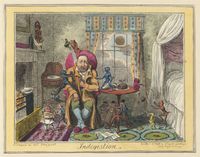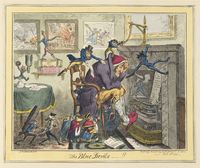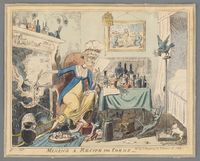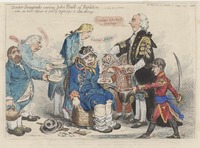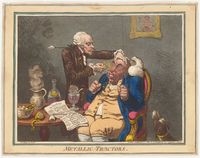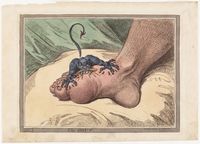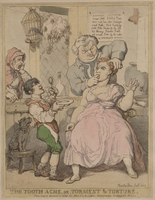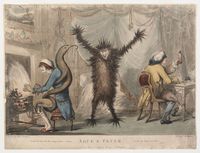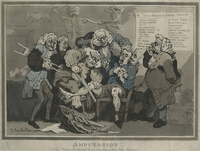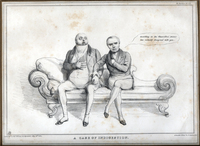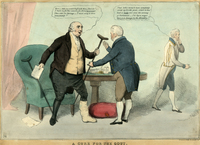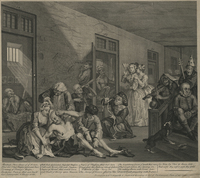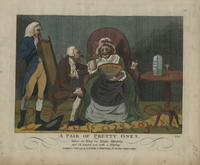Browse Items (18 total)
- Tags: Exhibit: Language of the Age
Sort by:
Indigestion
This print is part of a set that illustrates the discomforts and pain of illness. Note the use of the little demons to explain the cause of pain and illness.
Cholic
This print is part of a set that illustrates the discomforts and pain of illness. Note the use of the little demons to explain the cause of pain and illness.
The Blue Devils!
This print is part of a set that illustrates the discomforts and pain of illness. Note the use of the little demons to explain the cause of pain and illness.
Mixing a Recipe for Corns
Amidst the chaos of her home a grotesque woman is fixated on a conjuring a cure for her corns. Cruikshank is commenting on the pitfalls of self-medication.
The Central Board of Health: Cholera Consultation
In the early nineteenth century cholera epidemics were common. The disease struck its victims rapidly and spread fear amongst the populace. Medical science was ineffective against cholera until John Snow's discovery of its contagion through…
Dr. Sangrado Curing John Bull of Repletion
An excellent example of the use of medical metaphor for political comment, this print depicts one of Gillray's favorite targets, Henry Addington, Prime Minister 1801-1804, bleeding John Bull (Great Britain). Addington, the son of a physician, was…
Comfort to the Corns
Gillray, true to the form of caricature, exaggerates the size of the woman's features and the knife she uses to rid herself of corns.
Metallic Tractors
In 1796 Elisha Perkins, a physician from Connecticut, patented the metallic tractors shown in this print. He claimed the tractors could cure disease through electric force. Gillray's skepticism of this treatment is clear in this satire.
The Gout
Gillray powerfully illustrates the pain and suffering caused by gout, a common ailment of his time.
The Toothache or Torment and Torture
Rowlandson comments on dentistry in this work, suggesting that treatment in the days before anesthesia was as painful as the ailment.
Ague and Fever
Originally published by Rowlandson in 1788, this print shows Ague, the snake, wrapped around the patient, while Fever, the furry monster, stands behind him. On the right is a physician writing a prescription.
A quote by Milton on the bottom of the…
Dropsy Courting Consumption
Dropsy, the stout man, is shown courting consumption, the withered woman. Rowlandson contrasts these 19th century figures to the statue of the classical Hercules.
The Amputation
Rowlandson's derision of the medical profession is illustrated by a group of doctors attempting an amputation.
A Case of Indigestion
In this satire Doyle depicts the Duke of Gloucester with a case of indigestion. The Duke is apparently unaware that of his discomfort is caused by his host's insults at dinner as the doctor states, "Something in the Chancellor's dinner has certainly…
A Cure for the Gout
In this political commentary, Doyle uses gout as a metaphor for the discomfort of the political party that has long been out of favor. When Lord Holland discovers that his party, the Whigs, have been returned to power his gout is cured. Lord Holland…
In Bethlehem Hospital (Bedlam)
Published as the last of a series of eight engravings entitled, A Rake's Progress, this print depicts the story of Tom Rakewell, a wealthy youth who squanders his inheritance because of immorality, carelessness and greed. As he descends into madness,…

